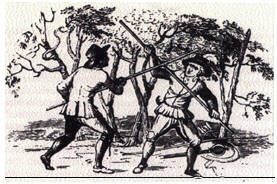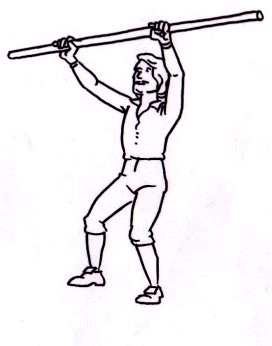Defend your familie's good name and your sheep...
Learn about Eighteenth Century Pole Arms below:
"I might here speak of the excessive staves which divers that travel the waidoo carry
upon their shoulders whereof some are twelve or fourteen foot long besides a pike of
twelve....No man traveleth by the waie without his sword or some such weapon except
it be the minister who commonly weareth none at all unless it be a dagger or hanger
at his side "
(Description of England. William Harrison 1534-93)
The Quarterstaff was for centuries considered the weapon of the lower sections of society,
although the nobility had a healthy respect for the Quarterstaff, which they also
practised. In reality Quarterstaffing, as a fighting art reigned supreme in England
for many centuries.
Due to the fact that weapons and smithys came at high prices, a person's income often determined what types of weapons he
would be versed in. For farmers, peasants, and the lower classes, wood was a readily available resource. This, combined with
the fact that the stick is the oldest weapon in Human history gave rise to the staff being the most common weapon for men of
this level. The dagger, which was much cheaper than a full sword was also favored by these men. This is not to say that
the lower classes never used the sword. For in times of conflict weapons would have been distributed, however pole arms were
favored for their relative ease of use. In order to be proficient, little training was necessary.

The quarterstaff was an extremely versatile weapon, it could be used as freely
as the "staffer" wished to use it. When used to strike or hit it was similar to the
strikes of the two-handed sword or battle axe, when used to thrust it became like a spear,
strikes and thrusts could be from either side of the body. This made it very difficult for
any opponent to respond quickly to these attacks, that could change so readily from side
to side, and from thrust to strike without pause.
George Silver wrote about the quarterstaff claimed it was a weapon he used to
fight and defend his honour with. His recounts of English quarterstaff fighting
were from experience. In the following extract from his book Paradoxes of Defence
he said:
"The short staff hath the vantage against two swords and daggers, or two rapiers and
poinards, and gauntlets, the reason and causes before are for the most part set down
already, the which being well considered, you shall plainly see, that whensoever any
one of the sword and dagger men, or rapier and poinard men shall break his distance,
or suffer the staff man to break his, that man which did first break his distance,
or suffer the distance to be won against him, is presently in dangr of death. And
this cannot in reason be denied, because the distance appertaining to the staff man,
either to keep or break, standeth upon the moving of one large space always at the most,
both for his offence or safety. The other two in the breach of their distance to offend
the staff man, have always four paces at the least therin they fall to great in number
with their feet, and too short in distance to offend the staff man."
The quarterstaff as a weapon was very popular among the lower classes as well as among the middle class.
James Figg had his famous school of defence in or near Tottenham court road in London.
Figg was a reknowned maister with the sword, and quarterstaff, as well as the bare knuckle boxing
champion of England. Every maister was expected to have an deep knowledge of quarterstaffing
even if they did not focus on it at their academies.
